TROBOLO TinyBlœm
Wooden composting toilet for permanent installation with urine drainage and integrated exhaust system.
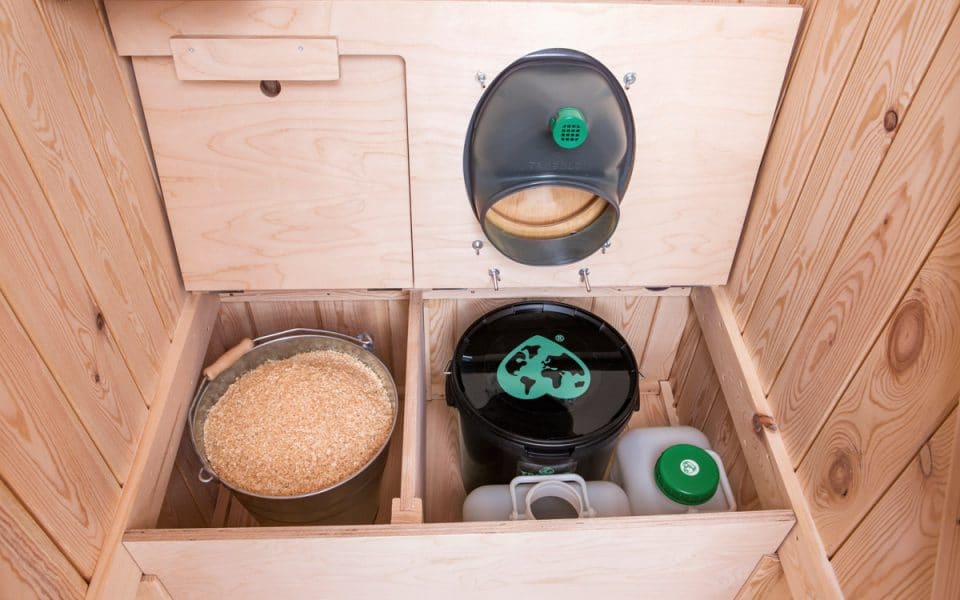
Below you will find information on functionality, areas of application as well as advantages and disadvantages of dry toilets.
Dry toilets are becoming more and more popular. Dry toilets are increasingly being used, in particular by weekend and holiday home owners, or as a toilet solution in garden houses or allotments.
Even though these toilets do not require any water at all, no compromises in terms of hygiene are necessary: even without water or (toilet) chemicals, separating and dry toilets are not only particularly environmentally friendly, but also hygienic and odourless thanks to the way they function.
In this article we will explain what other advantages make the purchase of a dry toilet attractive, how they work exactly, but also what disadvantages can arise in individual use cases.
Since the terms dry toilet and separating toilet are often used synonymously both in online forums and in colloquial speech, it is necessary at this point to clarify these terms.
Separating toilets are always dry toilets, with the exception of a few models that can also be operated with water. On the other hand, dry toilets are not necessarily separating toilets! All dry toilets, such as the compost toilet, are waterless toilet systems, but most do not separate the excreta. Dry toilets are therefore characterised above all by the fact that they do not require flushing with water and consequently do not need to be connected to a sewage system. They are therefore a waterless alternative to the conventional toilet, which at the same time relieves local sewage systems.
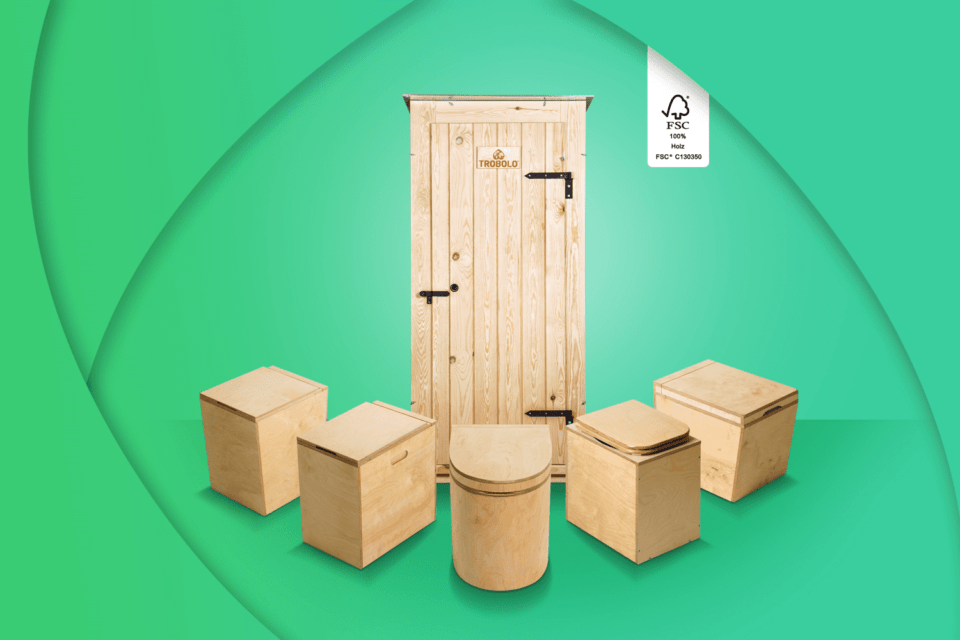
As the name suggests, it is the other way round with separating toilets. With the aid of a separating insert or separator, liquid is separated from solid waste and collected in a separate container. It is therefore a dry toilet with a separation system. Urine is fed into a container at the front, while faeces and toilet paper end up in a solids container in the rear area, where they are covered with litter after each toilet visit. This removes liquids from solid matter and at the same time prevents formation of unpleasant odours.
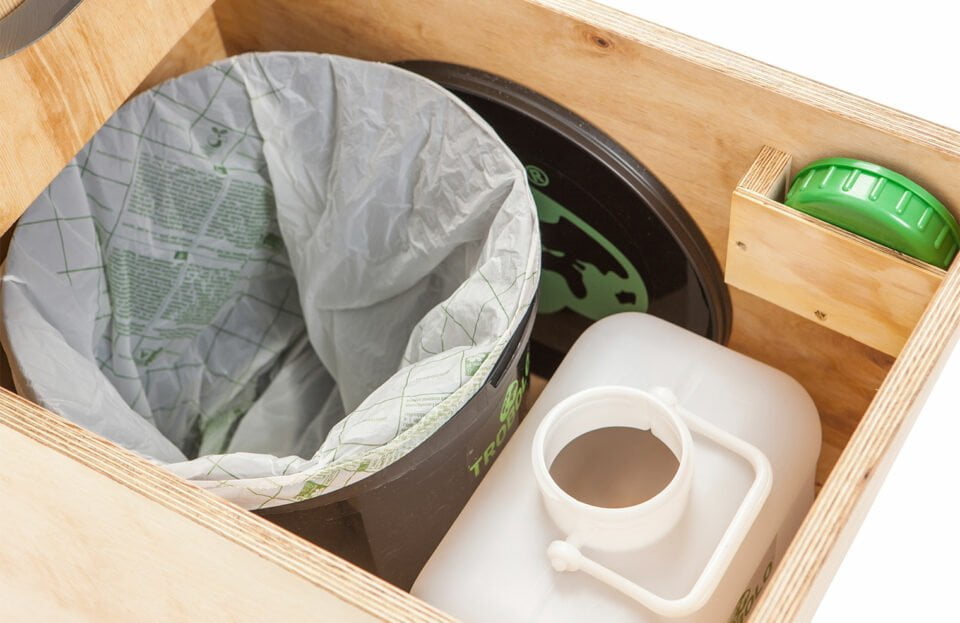
An electrical exhaust system can also be used for this purpose. Some systems, such as the TROBOLO LuweBlœm with electric exhaust system, work so efficiently that it eliminates any need for litter. Even just separating urine from faeces reduces odour formation to a minimum, as it is precisely the mixing of solid and liquid excreta that causes such odours in the first place. One of the main reasons for separating urine from faeces is therefore the prevention or minimisation of odours. Another reason is the easy disposal and further use of toilet waste as compost, which is made possible thanks to the separation process.
The separating or dry toilet has an appearance similar to a conventional toilet.
However, it looks a bit different on the inside. Dry toilets with a separation system are based on the rather simple idea of collecting urine and faeces separately. This makes sense because faeces make up only about 10% of our excrements. Urine, if collected separately (yellow water), can be disposed of much more easily than when it is mixed with faeces (black water). Thanks to the separation procedure, considerably less toilet waste is produced, which needs to be composted or disposed of in the same manner as household waste, such as used diapers.
In order to ensure separation, a separator is used in dry toilets, which directs urine into a liquids container at the front; whereas faeces end up in the rear part of the toilet in a solids container, where they are collected without coming into contact with the container itself, thanks to the use of so-called inlays (collection bags). After the “business” has been completed, a quantity of litter is finally added to the solid precipitates in order to bind any residual liquids.
In some models with an electrical exhaust system, the use of litter is not necessary, as odours and moisture are reliably removed through ventilation. If you decide to use an electrical exhaust system, the user of litter is not necessary. Used toilet paper can also be placed directly in the collection container
So now you know how a dry toilet works in theory.
But what does it look like in practice?
Ok, the way a dry toilet works is significantly different to a conventional toilet. Nevertheless, users of a dry toilet do not have to prepare themselves for any drastic changes when using the toilet.
This is because the separation of faeces is contact-free, reliable and more or less by itself, thanks to the separator. As with a normal toilet, direct physical contact only occurs with the toilet seat.
Why now more or less by itself?
It’s simple: the sitting position on a dry toilet is the same as on a toilet. However, urinating standing up is not recommended under any circumstances. If you can’t do without it, you need to be pretty practised at what you’re doing to ensure separation. In that case: Chapeau!
Proper use of the dry toilet can significantly minimise or delay the occurrence of unwanted odours.
Let’s take a closer look at this.
Because many new users of dry toilets are often very concerned about odours, we show you what is important in the following video:

To summarise: Separating solid and liquid excretions effectively prevents the main cause of odour formation.
This is because unpleasant odours are caused in particular by the mixing of solid and liquid excrement. When these two excretions meet, the moisture content is inevitably particularly high, which in turn has a catalysing effect on odour formation.
In addition, the putrefaction and decomposition processes of the mixed excrement lead to the formation of ammonia, which is responsible for the majority of unpleasant odours.
Fortunately, thanks to the separation principle, this risk does not exist with dry separation toilets.
Nevertheless, we recommend wiping out the separator insert briefly after every visit to the toilet. For example, with a piece of (damp) toilet paper or a cloth and a splash of organic cleaner.
The less residue that sticks to the separator, the fewer unwanted odours you will have to deal with afterwards.
The appearance of unpleasant odours is also delayed if a sip of vinegar is poured into the liquid container at regular intervals (author’s tip: 2 x daily or 1 x in the morning, 1 x in the evening). The vinegar neutralises unwanted odours that could escape from the container. (Caution: water has exactly the opposite effect!)
In order to really eliminate odours, the installation of an electrical exhaust air system is also recommended. This conveys residual odours and any moisture to the outside via an exhaust air duct.
The exhaust air duct is installed either vertically at a height of around two metres so as not to disturb surrounding areas with odours or horizontally directly through the outer wall, provided there are no occupied areas directly behind it.
An efficient exhaust air system prevents 100% of residual odours from escaping from the dry toilet and is even more convenient in this respect than a conventional system.
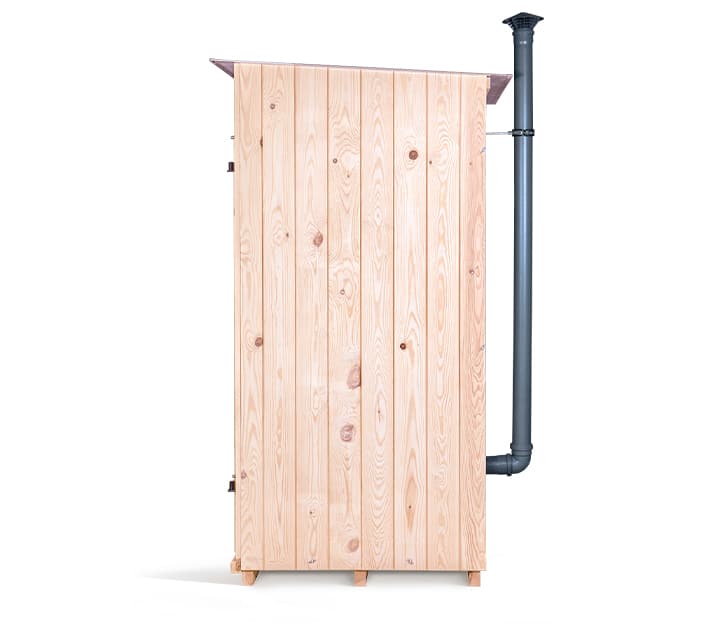
As soon as the dry toilet with separation system is ready for use, in addition to litter which binds the faeces, only inlays for the solids container are needed to cleanly dispose of its contents. Depending on the disposal method, inlays made of plastic or biodegradable material, such as maize starch, can be used, which will then be disposed into a composter, along with its contents. However, it should be noted that compostable inlays have a limited shelf life and, like the solids themselves, decompose eventually, which is why it is advisable to change them on a weekly basis. Inlays made of plastic, on the other hand, have an unlimited shelf life and are therefore particularly suitable for longer intervals between disposals, which can be achieved with separation toilets that have an electrical exhaust system installed. Furthermore, the use of plastic inlays does not rule out composting the toilet waste, as it is much drier than one might expect. In this case, inlays and solids can easily be disposed of separately.
In this video, we take a closer look at the two inlay variants that you can use to line your solids container:

Thanks to inlays, cleaning of the solids container is kept to a minimum, as the precipitates never come into direct contact with it. After removing the inlays, cleanliness and hygiene of the solids container can be restored quickly and easily by occasionally wiping it with a damp cloth.
Disposal of the precipitates in dry toilets with separation system is problem-free and takes only a few steps, but may have to be performed in accordance with official guidelines. Urine can either be diluted with water and used as fertilizer or disposed of in a toilet connected to the main sewage system. Solid excreta can be disposed of – similar to diapers – in household waste if they are kept in plastic inlays, or in the organic waste bin if suitable bags are used.
However, it is important to enquiry with local authorities about proper disposal methods. Sometimes compostable inlays can cause problems in regional disposal stations or biogas plants, which is why this type of disposal is prohibited in many communities. For this reason, decentralised composting of biomaterial in one’s own garden is often recommended, which also respects the natural cycle of such materials. In any case, one should enquire in advance with local authorities as to the planned method of disposal.
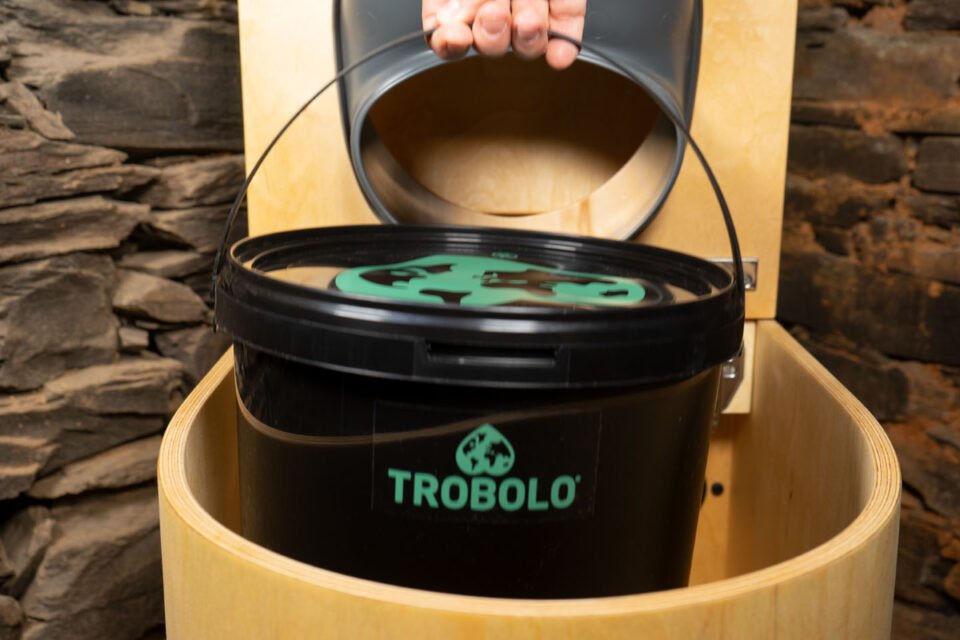
Once urine and faeces have been disposed of, cleaning of a dry toilet with separation system can then be carried out in just a few steps and with minimal effort. As already mentioned, the two storage containers can be wiped off with a damp cloth if necessary. The hygienic maintenance of the outer components of the dry-separating toilet, such as the toilet seat, is also straightforward and can be carried out in a few simple steps. As with a conventional toilet, cleaning with a cloth and some cleaning agent is entirely sufficient.
he functionality of dry toilets opens up a wide range of applications. Since neither access to water mains nor a connection to the sewage system is required, a dry toilet can be installed and used almost anywhere. This flexibility and independence means that they are mostly used where the aforementioned utilities are either not present, or too difficult to access. These toilets can be used both indoors and outdoors. For example, gardens, golf courses, dog schools, riding stables or day-care centres are ideal locations for outdoor dry toilets. As for indoors applications, dry toilets are suitable for use in holiday homes, gazebos, caravans, mobile homes and boats.
The particular advantages and disadvantages of using a dry toilet with separation system are illustrated as follows:
The above remarks show that dry toilets with a separation system are far more than just an alternative to conventional toilets, in cases where those cannot be operated, for example due to a lack of access to water. Dry toilets with a separation system are also odourless, do not contain any chemicals and are also extremely environmentally friendly due to their waterless operation, as well as the possibility of composting excreta. In addition, our TROBOLO dry toilets are made of high-quality and durable wood, and can be set up quickly and easily anywhere.
Sign up for our newsletter here to never miss out on any news or free promotions.
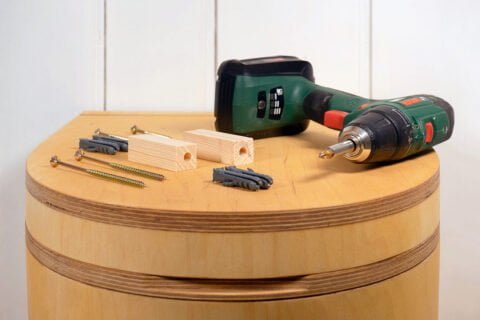
"Do-it-yourself" is the latest trend, so it's not surprising that more and more people want to build their composting toilet themselves. But how does that actually work? In this article, we take a closer look at the topic and give you numerous tips and tricks to make your do-it-yourself project a success. Have fun!
Read more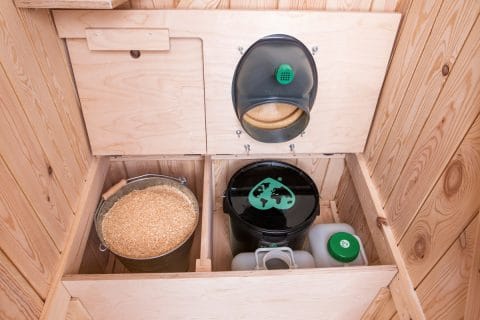
Below you will find information on functionality, areas of application as well as advantages and disadvantages of dry toilets.
Read more
In this guide, you will find information about the functionality, areas of application as well as the benefits and disadvantages of chemical toilets.
Read more¡Tenemos buenas noticias! Aunque gran parte de nuestro contenido todavía esté en inglés, ya hacemos envíos a tu país. Solo tienes que hacer el pedido y los productos te llegarán directamente a casa.
De acuerdoBuone notizie! Anche se la maggior parte dei nostri contenuti è ancora in inglese, spediamo già nel tuo paese. Fai un ordine e ricevi i prodotti direttamente a casa tua.
D'accordoVi har gode nyheder! Selvom det meste af vores indhold stadig er på engelsk, sender vi nu til dit land. Du skal bare afgive din ordre, så bliver produkterne leveret direkte hjem til dig.
ForståetWe hebben goed nieuws! Hoewel het meeste van onze inhoud nog steeds in het Engels is, verzenden we nu naar uw land. Plaats uw bestelling en de producten worden direct bij u thuisbezorgd.
BegrepenYou are currently viewing a placeholder content from Facebook. To access the actual content, click the button below. Please note that doing so will share data with third-party providers.
More Information